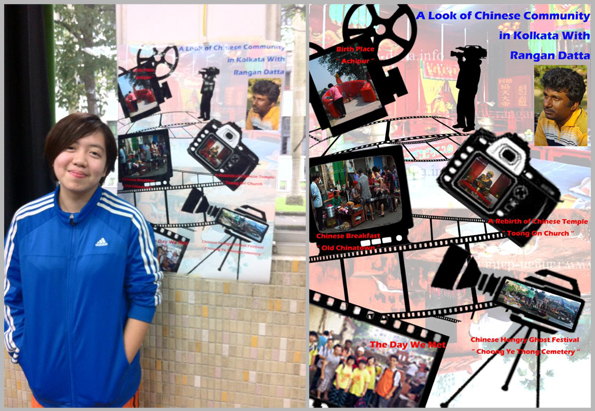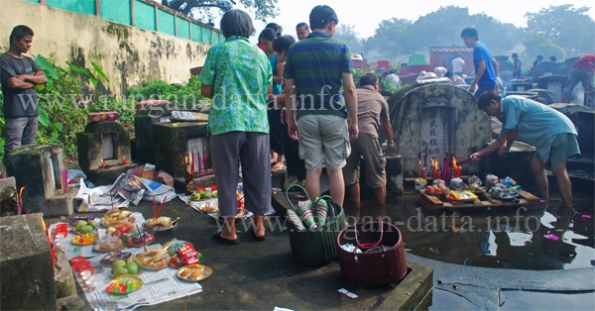Cross Cultural Communication with Kolkata Chinese
Cross Culture Communication between Indian
photographer Rangan Datta and Kolkata Chinese
Travel Journal by Wendy Lu, Fu Jen Catholic University, Taiwan
Also see: My blog post on Calcutta (Kolkata) Chinatown
During the 21-day visit in Tangra, new China Town in Kolkata, a group of students (we) from Fu Jen University TW met two Indian Photographers. Asked why they took photos of Indian Chinese sweeping the tombs in the graveyard, Choong Ye Thong Cemetery, photographers Rangan Datta and Manjit Singh Hoonjan said they were very interested in the cross-cultural activities in Kolkata. “and Indian Chinese is the case.” said Rangan Datta.
Knowing the existence of Indian Chinese:
When Rangan studied in St. Xavier’s School, Calcutta, he had a few Chinese students as classmates. It was during this time he came to know about the existence of a large Chinese community in Calcutta, but Rangan said, at that time there was not much interaction as Indian Chinese prefer to remain secluded.

Group Photo at the Choong Ye Thong Cemetery during Hungry Ghost Festival (Photo courtesy: Calcutta Photo Tour)
The passion of observing Indian Chinese by travelogues:
Rangan’s interest of observing Indian Chinese started in early 2000s when he started writing travelogues for leading dallies in Calcutta. In 2011 he started his own travel blog, mainly focusing on Calcutta history and culture. Indian Chinese obviously was his focus.
Mentioned where did the passion come from, “after doing my post graduate in Management, I started writing regularly for English newspapers. In 2011 I started Blogging mainly to showcase my works on Calcutta, within two and half years it is quiet popular.” Rangan said.
It’s always passionate for him to observe Chinese community, the cross-cultural communication between the two.
Breaking the boundaries:
“My shooting and writing (bloging) have helped me to break into the Chinese Community in Tiretta Bazar and Tangra, which was initially not very friendly.”
Over time the Chinese have become extremely friendly and people like Dominic Lee has helped him in all possible ways. Rangan mentioned that initially when he approached the community of Tiretta Bazar and Tangra, they were a bit reluctant, questioning him why he was taking the photos or what would he do with them.
But once the blog entry started coming up, Rangan found that the Calcutta Chinese were sharing it in their community blogs or FB pages. They soon understood that his objective was to put forward their unknown cultures to the world.
Observation:
Rangan had told me his own perspective of Indian Chinese. The Chinese have been able to preserve their cultures to a great extent, even 4/5th generation of Kolkata Chinese still speak Chinese at home.
Festivals like Chinese New Year, Moon Festival and Ghost Festivals are still celebrated following traditional rituals and customs.
However, recent years there is some influence of Western culture in the Calcutta Chinese Community and probably the Bollywood Industry (the Bombay based Hindi film industry) has had its effect. Young Chinese can be seen dancing to Bollywood tunes during Chinese New Year Festivals.
Chinese Hungry Ghost Festival, the festival we met:
“As per my knowledge but festival deals with paying homage to the dead, I think this is practiced in religions where dead are buried, Islam and Christianity also have a similar festival.”
In his own observation, in All Souls Day (the Christian equivalent of Chinese Hungry Ghost Festival) the graves are more elaborately decorated with flowers and candles but there is no food. As for Hungry Ghost the food is the main item. In my own view the reason why Chinese contribute their ancestors with the cooked-food. The food is usually for the deceased to enjoy their big feast once or twice in a year.
Anthropological investigation to this community:
Minority communities of the city have always been Rangan’s areas of interest. For Chinese he has visited Achipur, the place named after the first Chinese settler in India, Tong Achew. Achipur is regarded as the first Chinese settlement in India. He has also covered the Chinese Temples and Graveyards in Old and New Chinatown. As for what impresses him the most, Rangan says “Chinese Temples and the Choog Ye Tong Cemetery.” Rangan also mentions about Dominic Lee, a Kolkata Chinese, who has taken him all over the city to unlock the mysteries on Calcutta Chinatown, need special mention.”
The future of Indian Chinese in the perspective of Rangan:
“If you have asked the question whether the Chinese community would disappear two years back my answer would have been yes, but presently it is a strong NO.” Rangan emphasized.
The reasons are that the Calcutta Chinese themselves are getting interested in promoting their culture as a tourist item. With the plans of renovating the ToongOn Church, the Calcutta Chinese are all set to bring back their past glory and turn Calcutta Chinatown into a tourist spot as in Boston, Sydney and San Francisco.
“They won’t disappear and will keep their roots on Kolkata.”
Special thanks:
The encounter with Rangan Datta and Manjit Singh Hoonjan was a surpris and a nice experience for me. At the moment I saw them in the graveyard, I was so curious about their motives of taking photos in the Chinese Community. Rarely did I saw Indian break the boundary in the days I was In Tangra. It was exciting to know part of the Indian were interested in Chinese Culture and made a few very unique observation of their own.
It was also exciting for me to distinguish the difference between Indian Chinese and Taiwan’s culture. This was exactly my goal of this trip.
During the 21-day stay in Tangra, Kolkata, I got the chance to better understanding the history of India Chinese, had further brainstorming of the same but also different culture we Chinese shared, and communicated without the border with Rangan Datta and Manjit Singh Hoonjan, the two brilliant photographers. Special thanks to Rangan, who spares time to answer my questions and Albert Tang, who is my guided professor for all the things in n after the trip.
Note: This is a guest post written by Wendy Lu of Fu Jen Catholic University, Taiwan under the guidance of Prof. Dr. Albert Tang. The post have been uploaded with minor edits and modification.

















Good to know about this community and the place.
Thanks Indrani
Awesome! Didn’t have so much information on the Chinese living in Kolkata!
Thanks Sourav